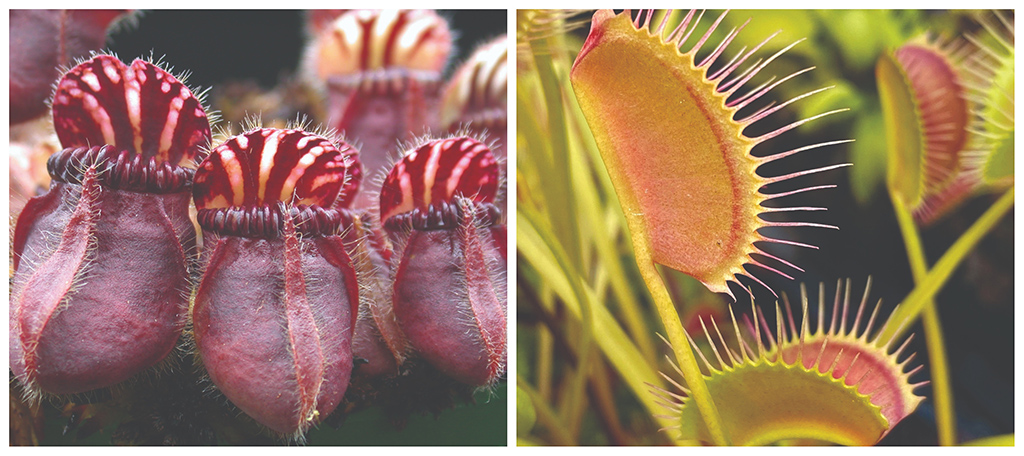
On the left: Cephalotus Follicularis (australian pitcher plant), Carnivorous Plant Nursery. On the right: Dionaea m. ‘seedgrown’ (venus flytrap), California Carnivores
Right around Thanksgiving, a cheeky meme circulated on social media, announcing the arrival of “the 2020 poinsettias.” (The post featured Audrey II, the enormous Venus flytrap with an appetite for human blood, of Little Shop of Horrors fame.) In reality, of course, carnivorous plants feast on insects and arachnids, not people — and they actually have many admirers, due to their striking looks, pest-reducing benefits and simple care and handling needs.
“They’re so charismatic,” said Damon Collingsworth, co-owner of California Carnivores. “They’re famous for catching bugs, but they caught my affection a long time ago.” Collingsworth purchased his first carnivorous plant (a Cape sundew) at a flea market when he was in grade school from his now business partner, Peter D’Amato, author of the award-winning book, The Savage Garden. He went on to manage the nursery at Malesiana Tropicals in Borneo; upon his return to the U.S., he built California Carnivores into the country’s largest botanical collection of carnivorous plants.
Although popular with aristocrats in Victorian England, carnivorous plants were long considered “weird” stateside, Collingsworth said. In recent years, however, demand has exploded. “2020 was our busiest year ever,” he said. “I think all biology-oriented products and hobbies have taken off during the pandemic, as people crave being around living things.” The public’s obsession with houseplants, which has grown steadily over the past decade, has helped fuel interest, he added, as certain genera (Drosera and Pinguicula, commonly known as sundews and butterworts) catch fungus gnats — small flies that commonly infest the soil of potted plants. Others, such as Sarracenia, Nepenthes and Cephalotus (pitcher plants), help combat some more vicious bugs, including mosquitos, ants and wasps.
Native to swamps and bogs, carnivorous plants evolved in environments absent of fertilized soil and can only tolerate very pure water (rain or distilled). Most can handle a wide range of temperatures, from 15 F to 100 F or more, and thrive on a sunny windowsill. (If you are in an especially frigid location, Collingsworth advises bringing them into a garage rather than a home or shop with the heat running full blast.) Many carnivorous plants go dormant in the winter, “but so long as you keep giving them distilled water, they’ll come back and you can totally enjoy them for a lifetime,” he said.
A great way to merchandise carnivorous plants — and set your customers up for success — is to keep them in an open terrarium. “To grow healthy carnivorous plants, it is important to duplicate their habitat as closely as possible,” said Michael Szesze, owner of the Carnivorous Plant Nursery in Smithsburg, Maryland, and founding father and curator for the Mid-Atlantic Carnivorous Plant Society. “Open terrariums keep the moisture and humidity up and allow the plants free access to insects.” He recommends misting the soil with a bottle of distilled water once a week and placing the terrarium in a spot that receives bright, but indirect light. “Direct light would bake the plants, killing them,” Szesze said. “Close to a window or near a bright fluorescent light is good.”
Check out beautiful options of these pretty predators in the Jan/Feb issue of Floral Mangement.
Katie Vincent is the senior contributing editor of Floral Management.

